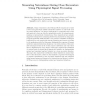Free Online Productivity Tools
i2Speak
i2Symbol
i2OCR
iTex2Img
iWeb2Print
iWeb2Shot
i2Type
iPdf2Split
iPdf2Merge
i2Bopomofo
i2Arabic
i2Style
i2Image
i2PDF
iLatex2Rtf
Sci2ools
IEAAIE
2009
Springer
2009
Springer
Measuring Naturalness during Close Encounters Using Physiological Signal Processing
Many researchers in the HRI and ECA domains try to build robots and agents that exhibit human-like behavior in real-world close encounter situations. One major requirement for comparing such robots and agents is to have an objective quantitative metric for measuring naturalness in various kinds of interactions. Some researchers have already suggested techniques for measuring stress level, awareness etc using physiological signals like GSR and BVP. One problem of available techniques is that they are only tested with extreme situations and cannot according to the analysis provided in this paper distinguish the response of human subjects in natural interaction situations. One other problem of the available techniques is that most of them require calibration and some times ad-hoc adjustment for every subject. This paper explores the usefulness of various kinds of physiological signals and statistics in distinguishing natural and unnatural partner behavior in a close encounter situation. T...
Artificial Intelligence | Close Encounter Situations | IEAAIE 2009 | Physiological Signals | Real-world Close Encounter |
| Added | 26 May 2010 |
| Updated | 26 May 2010 |
| Type | Conference |
| Year | 2009 |
| Where | IEAAIE |
| Authors | Yasser F. O. Mohammad, Toyoaki Nishida |
Comments (0)

